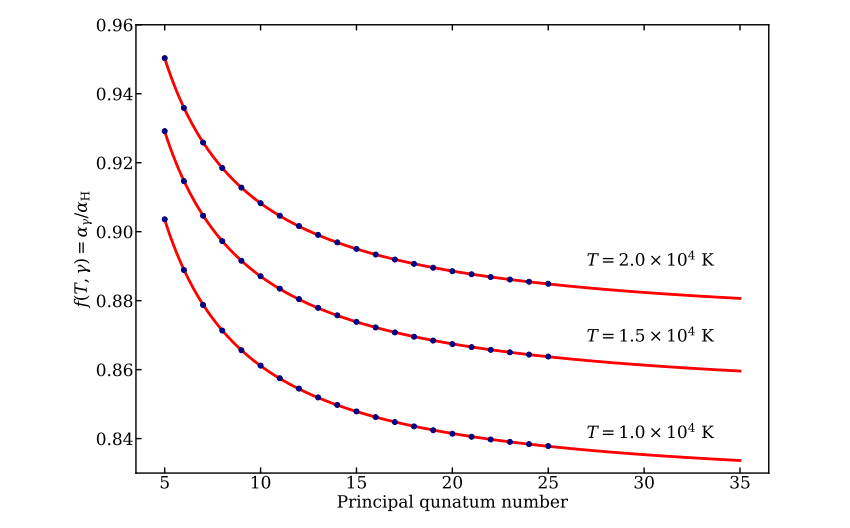Helium emission lines provide crucial insights into astrophysical plasmas, yet accurately interpreting these signals requires precise modelling of how radiation interacts with the emitting gas. Oleg Kurichin and Alexandre Ivanchik, both from the Ioffe Institute, along with their colleagues, now present a significantly improved model for calculating helium emission, addressing limitations in previous approaches. Their work reveals that existing calculations systematically misrepresent the strength of key emission lines, particularly when the gas is dense enough for radiation to become trapped and re-emitted. By incorporating detailed radiative transfer corrections, the team generates highly accurate predictions for a wide range of helium emission lines, offering a valuable tool for determining the abundance of helium in the universe and improving spectroscopic analyses of diverse astronomical objects.
Helium Transition Probabilities for Plasma Modelling
This research focuses on providing highly accurate data for calculating the light emitted by helium in hot gases, such as those found in nebulae and stellar atmospheres. The data consists of coefficients that allow scientists to precisely calculate the strength of spectral lines, revealing information about the temperature, density, and composition of these gases. These coefficients are essential for interpreting astronomical spectra and understanding the physical conditions within these environments. The study provides two key sets of coefficients: one calculates the probability of transitions between different energy levels within helium atoms, determining the intensity of emitted or absorbed light, and the other calculates the rate at which helium ions recombine with electrons, a process that also emits light and contributes to the overall spectrum.
The data incorporates detailed calculations and accounts for the complex interactions between electrons and helium atoms. By using these coefficients in radiative transfer models, astronomers can accurately simulate how light propagates through hot gases, allowing them to interpret observed spectra and diagnose the physical conditions of plasmas in various astrophysical environments. The precision of this data is crucial for accurately determining the composition, temperature, and density of these gases, leading to a better understanding of the universe.
He I Spectrum Model Accounts for Optical Depth
Scientists have developed a new model for calculating the spectrum of light emitted by helium, incorporating the latest atomic data and accurately accounting for the effects of optical depth, which describes how easily light can travel through a gas. The model specifically addresses the impact of optical depth on light emitted from transitions to a metastable state in helium, a key consideration for accurate calculations. The team calculated the amount of light emitted by helium across a wide range of densities and temperatures, typical of conditions found in nebulae and planetary systems. They found that previous models systematically underestimated or overestimated the intensity of certain helium lines by 5 to 20 percent, a significant discrepancy now addressed by their new approach.
This improvement stems from accurately accounting for the absorption and re-emission of light within the gas. The researchers also developed new formulas to correct for the effects of radiative transfer, ensuring high precision in their calculations. This new model expands the range of conditions under which accurate calculations can be performed, including those found in low-metallicity dwarf galaxies. By incorporating a larger number of energy levels and using modern atomic data, this model provides a more reliable and accurate description of helium emission in diverse astrophysical environments.
Helium I Spectrum, Radiative Transfer, and Emissivity Corrections
This research presents an improved model for calculating the spectrum of light emitted by helium in hot gases, building upon the most current atomic data available. The model accurately accounts for the effects of radiative transfer and the influence of optical depth, which describes how easily light can travel through a gas. This is particularly important for light emitted from transitions to a metastable state in helium, a key consideration for accurate calculations. Scientists calculated the amount of light emitted by helium across a wide range of densities and temperatures, typical of conditions found in nebulae and planetary systems.
They found that previous models systematically underestimated or overestimated the intensity of certain helium lines, a discrepancy now addressed by their new approach. This improvement stems from accurately accounting for the absorption and re-emission of light within the gas. The team also developed new formulas to correct for the effects of radiative transfer, ensuring high precision in their calculations. These advancements provide a more accurate determination of the abundance of helium in the universe and enhance the ability to accurately interpret spectroscopic data from astrophysical objects. By addressing limitations in previous models and expanding the range of applicable conditions, this research provides a valuable tool for astronomers.
Accurate Helium Emission Across Nebular Conditions
This research presents a refined model for understanding the spectrum of light emitted by helium in hot gases, building upon the most current atomic data available. The model accurately accounts for how radiation transfers within the gas and considers the impact of optical depth, which describes how easily light can travel through a gas. This is particularly important for light emitted from transitions to a metastable state in helium, a key consideration for accurate calculations. Scientists calculated the amount of light emitted by helium across a wide range of densities and temperatures, typical of conditions found in nebulae and planetary systems.
They found that previous models systematically underestimated or overestimated the intensity of certain helium lines, a discrepancy now addressed by their new approach. This improvement stems from accurately accounting for the absorption and re-emission of light within the gas. The team also developed new formulas to correct for the effects of radiative transfer, ensuring high precision in their calculations. These advancements provide a consistent and accurate description of the helium recombination spectrum, offering a solid foundation for future studies aimed at determining the abundance of helium in the universe and analysing spectroscopic data. The research expands the range of applicable conditions and provides a valuable tool for astronomers.

